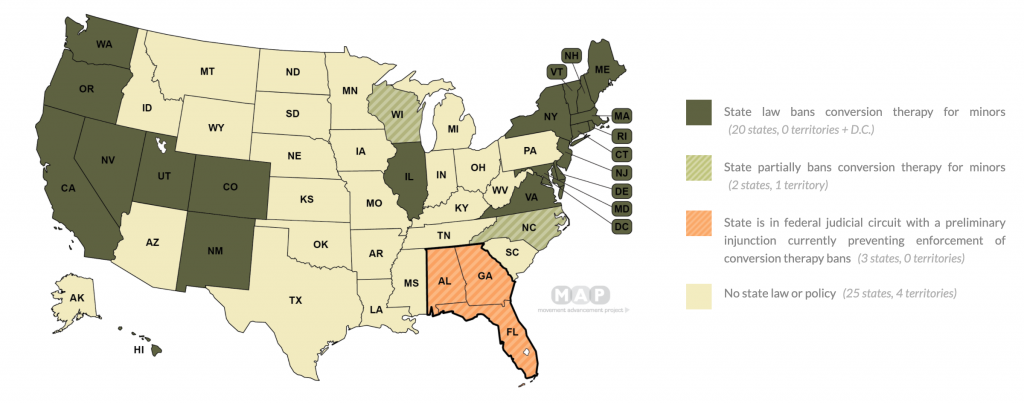
“It was, to my understanding, a socially acceptable and legally protected form of child abuse. I was tortured, and my parents were taught the tools of torture. It was a time when I felt very lost and abandoned in all the ways that mattered and overprotected and surveilled in every other. Eventually, I fled what can only be described as a witch hunt. I ran from persecution administered upon the basis of my gender and sexuality such that I became a teenage refugee in my own country.”
Clare Killman, Midwest Regional Director of Conversion Therapy Dropout Network
According to the Williams Institute, there are over 8 million adults in the United States that identify as gay, lesbian, or bisexual.18 The Williams Institute also suggested, that in 2016, there was an estimated 1.4 million adults that identified as transgender in the United States.19
The true extent of the population remains unknown due to sexual orientation concealment resulting from structural stigma and discrimination.9 This structural stigma has been associated with negative health outcomes amongst the LGBTQ population. These negative health outcomes include depression, anxiety, substance use disorders, suicide, and homelessness.10
LGBTQ youth often experience discrimination and stigma that stems from homophobic and transphobic attitudes.10 These attitudes are incited by social factors, such as social norms, culture, and religion.10
LGBTQ youth often face strained interpersonal relationships due to the stigma related to their sexual orientation and gender identity.13 Fjelstrom mentions that 85% of LGBT individuals are raised in a religious, homonegative environment.5 This environment can influence the decision for individuals to participate in sexual reorientation therapy, or sexual orientation change efforts (SOCE). The choice can be individual, coerced, or involuntarily forced by family members. 3,11 Since there are religions that denounce homosexuality, an individual may internalize homonegativity, and then seek out SOCE to remain active in the religious affiliation, or seek out SOCE to gain acceptance by the religious affiliation.11,17 Also, social norms, social cohesion, behavioral norms, moral behaviors, and maintaining social order can influence an individual’s decision in seeking out conversion therapy.11,16
There are several techniques that conversion therapists use in order to change one’s sexual orientation. These techniques can include: ceasing activities and suppressing interests that are seen as part of the ‘gay’ lifestyle.5,7 Participants of SOCE are encouraged to follow traditional gender roles and mannerisms that are deemed ‘heterosexual. Individuals are mandated to change manner of speaking, style of dress, and the way they non-verbally communicate.5 Other methods include being forced to pray, recite bible passages, accept homosexuality as a sin, and avoid spiritual damnation or going to hell.5,7,12
Those who participate in conversion therapy have reported other techniques used such as abstinence training, social skills training, cognitive restructuring, masturbatory reconditioning, castration, ovary removal, electric shocks on genitals, physical abuse, and sexual abuse.2,4,12 During masturbatory reconditioning, the individual uses masturbation to modify their sexual preferences or as a response to socially appropriate fantasies (i.e. a homosexual male masturbating to the stimuli of women).12 Abstinence training involves the individual withstanding from sexual activities while undergoing SOCE4. Cognitive restructuring focuses on changing an individual’s ‘irrational’ thoughts against heterosexuality.12 Methods may also include religious practices, behavioral modification, cognitive reframing, and counseling as a way to change sexual orientation from homosexual to heterosexual.5
For individuals who willingly seek out conversion therapy, or who are coerced into receiving this type of therapy, there are a variety of negative impacts, which include: suicidal ideation, spiritual harm, loss of social support, sexual dysfunction, de-masculinization, inauthenticity, and feelings of disconnect.5,7,15 Also, struggling with homosexual feelings, and periods of asexuality can occur after conversion therapy.5 LGBTQ youth are extremely vulnerable due to a lack of legal protections regarding consent of SOCE.6 Also, parents of sexual minority youth may not have accurate information on sexual or gender identities in order to make an informed decision about conversion therapy.3
In 1973, the American Psychological Association (APA) removed homosexuality in the DSM.7 In response to the negative impacts of conversion therapy, the APA released the “Resolution of Appropriate Therapeutic Responses to Sexual Orientation” in 1997. In 2007, the APA also developed a Task Force on Appropriate Therapeutic Responses to Sexual Orientation.1 There are several organizations that have made statements denouncing conversion therapy including the AMA, AACAP, ACA, and several others.8 To date, there are 20 states that ban conversion therapy among minors and there are still 26 states that have no laws regarding the practice (See Figure 1).14
With so many organizations releasing statements for opposing conversion therapy, there are many that still need to do so.

1. American Psychological Association. (2009). Report of the American Psychological Association task force on appropriate therapeutic responses to sexual orientation. Washington, DC: American Psychological Association.
2. Cella, A. S. (2014, March 1). A voice in the room: The function of state legislative bans on sexual orientation change efforts for minors. American Journal of Law & Medicine, 40(1), 113-140. https://doi.org/10.1177%2F009885881404000104
3. Cianciott, J. & Cahill, S. (2006) Youth in the crosshairs: The third wave of ex-gay activism. National Task Force Policy Institute. http://www.welcomingresources.org/crosshairs.pdf
4. Cramer, R. J., Golom, F. D., LoPresto., C. T., & Kirkley, S. M. (2008, March 31) Weighing the evidence: Empirical assessment and ethical implications of conversion therapy. Ethics & Behavior, 18(1), 93-114. https://doi.org/10.1080/10508420701713014
5. Fjelstrom, J. (2013, May 20). Sexual orientation change efforts and the search for authenticity. Journal of Homosexuality, 60(6), 801-827. https://doi.org/10.1080/00918369.2013.774830
6. Goishi, M. A. (1997). Unlocking the closet door: Protecting children from involuntary civil commitment because of their sexual orientation. Hastings Law Journal, 48, 1137-1182.
7. Haldeman, D. C. (2001, October 21). Therapeutic antidotes: Helping gay and bisexual men recover from conversion therapies. Journal of Gay & Lesbian Psychotherapy, 5(3-4). 117-130. https://doi.org/10.1300/J236v05n03_08
8. Human Rights Campaign (n.d.). The Lies and dangers of efforts to change sexual orientation or gender identity. https://www.hrc.org/resources/the-lies-and-dangers-of-reparative-therapy?utm_source=GS&utm_medium=AD&utm_campaign=BPI-HRC-Grant&utm_content=441709761103&utm_term=gay%20conversion%20therapy&gclid=Cj0KCQjw78yFBhCZARIsAOxgSx2hO87P6HR7-w72jTP83UX8VPZTYEGLJdG1_BjFrgfhi8h2rCTPXV0aApIREALw_wcB
9. Pachankis, J. E., & Bränström, R. (2019, June 13). How many sexual minorities are hidden? Projecting the size of the global closet with implications for policy and public health. PloS one, 14(6), e0218084. https://dx.doi.org/10.1371%2Fjournal.pone.0218084
10. Parker, C. M., Hirsch, J. S., Philbin, M. M., & Parker, R. G. (2018, August 23). The Urgent need for research and interventions to address family-based stigma and discrimination against Lesbian, Gay, Bisexual, Transgender, and Queer youth. The Journal of Adolescent Health, 63(4), 383–393. https://doi.org/10.1016/j.jadohealth.2018.05.018
11. Maccio, E. (2010, March 4). Influence of family, religion, and social conformity on client participation in sexual reorientation therapy. Journal of Homosexuality, 57(3), 441 458. https://doi.org/10.1080/00918360903543196
12. Morrow, S. L., & Beckstead, A. L. (2004). Conversion therapies for same-sex attracted clients in religious conflict: Context, predisposing factors, experiences, and implications for therapy. The Counseling Psychologist, 32(5), 641-650. http://dx.doi.org/10.1177/0011000004268877
13. Newcomb, M. E., LaSala, M. C., Bouris, A., Mustanski, B., Prado, G., Schrager, S. M., & Huebner, D. M. (2019, June 1). The Influence of families on LGBTQ youth health: A Call to action for innovation in research and intervention development. LGBT Health, 6(4), 139–145. https://doi.org/10.1089/lgbt.2018.0157
14. Movement Advancement Project (2021, May 26). Conversion “therapy” laws. https://www.lgbtmap.org/equality-maps/conversion_therapy
15. Serovich, J. M., Craft, S. M., Toviessi, P., Gangamma, R., McDowell, T., & Grafsky, E. L. (2008). A systematic review of the research base on sexual reorientation therapies. Journal of Marital and Family Therapy, 34(2), 227-238. https://doi.org/10.1111/j.1752-0606.2008.00065.x
16. Smith, G., Bartlett, A., & King, M. (2004). Treatments of homosexuality in Britain since 1950—an oral history: The experience of patients. British Medical Journal, 328(7437), 427-429. https://dx.doi.org/10.1136%2Fbmj.37984.442419.EE
17. Tozer, E. E., & Hayes, J. A. (2004). Why do individuals seek conversion therapy? The role of religiosity, internalized homonegativity, and identity development. The Counseling Psychologist, 32(5), 716-740. https://psycnet.apa.org/doi/10.1177/0011000004267563
18. Williams Institute. (2011). How many people are lesbian, gay, bisexual, and transgender? Retrieved from https://williamsinstitute.law.ucla.edu/research/census-lgbt-demographics-studies/how-many-people-are-lesbian-gay-bisexual-and-transgender/.
19. Williams Institute. (2016). How many adults identify as transgender in the United States? Retrieved from: https://williamsinstitute.law.ucla.edu/wp-content/uploads/How-Many-Adults-Identify-as-Transgender-in-the-United-States.pdf.
HPHR.org was designed by ComputerAlly.com.
Visit HPHR’s publisher, the Boston Congress of Public Health (BCPH).
Email communications@bcph.org for more information.

Click below to make a tax-deductible donation supporting the educational initiatives of the Boston Congress of Public Health, publisher of HPHR Journal.![]()